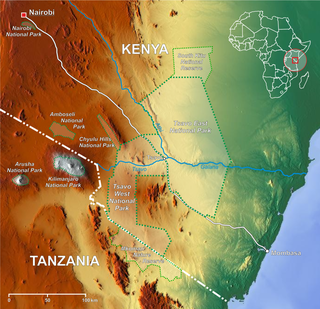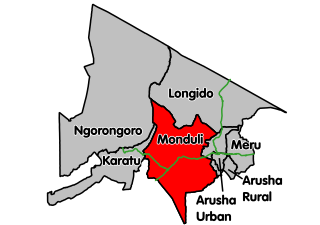
Maasai Mara, also sometimes spelled Masai Mara and locally known simply as The Mara, is a large national game reserve in Narok, Kenya, contiguous with the Serengeti National Park in Tanzania. It is named in honor of the Maasai people, the ancestral inhabitants of the area, who migrated to the area from the Nile Basin. Their description of the area when looked at from afar: "Mara" means "spotted" in the local Maasai language, due to the many short bushy trees which dot the landscape.

The Maasai are a Nilotic ethnic group inhabiting northern, central and southern Kenya and northern Tanzania. They are among the best known local populations internationally due to their residence near the many game parks of the African Great Lakes, and their distinctive customs and dress. The Maasai speak the Maa language, a member of the Nilotic language family that is related to the Dinka, Kalenjin and Nuer languages. Except for some elders living in rural areas, most Maasai people speak the official languages of Kenya and Tanzania, Swahili and English. The Maasai population has been reported as numbering 1,189,522 in Kenya in the 2019 census, compared to 377,089 in the 1989 census.

Amboseli National Park, formerly Maasai Amboseli Game Reserve, is a national park in Kajiado South Constituency in Kajiado County, Kenya. The park is 39,206 hectares in size at the core of an 8,000 km2 (3,100 sq mi) ecosystem that spreads across the Kenya-Tanzania border. The local people are mainly Maasai, but people from other parts of the country have settled there attracted by the successful tourist-driven economy and intensive agriculture along the system of swamps that makes this low-rainfall area, average 350 mm (14 in), one of the best wildlife-viewing experiences in the world with 400 species of birds including water birds like pelicans, kingfishers, crakes, hamerkop and 47 raptor species.
Ogiek is a Southern Nilotic language cluster of the Kalenjin family spoken or once spoken by the Ogiek peoples, scattered groups of hunter-gatherers in Southern Kenya and Northern Tanzania. Most if not all Ogiek speakers have assimilated to cultures of surrounding peoples: the Akiek in northern Tanzania now speak Maasai and the Akiek of Kinare, Kenya now speak Gikuyu. Ndorobo is a term considered derogatory, occasionally used to refer to various groups of hunter-gatherers in this area, including the Ogiek.

Maasai (Masai) or Maa is an Eastern Nilotic language spoken in Southern Kenya and Northern Tanzania by the Maasai people, numbering about 800,000. It is closely related to the other Maa varieties: Samburu, the language of the Samburu people of central Kenya, Chamus, spoken south and southeast of Lake Baringo ; and Parakuyu of Tanzania. The Maasai, Samburu, il-Chamus and Parakuyu peoples are historically related and all refer to their language as ɔl Maa. Properly speaking, "Maa" refers to the language and the culture and "Maasai" refers to the people "who speak Maa."
The Maa languages are a group of closely related Eastern Nilotic languages spoken in parts of Kenya and Tanzania by more than a million speakers. They are subdivided into North and South Maa. The Maa languages are related to the Lotuko languages spoken in South Sudan.
The Yaaku, are a people who are said to have lived in regions of southern Ethiopia and central Kenya, possibly through to the 18th century. The language they spoke is today called Yaakunte. The Yaaku assimilated a hunter-gathering population, whom they called Mukogodo, when they first settled in their place of origin and the Mukogodo adopted the Yaakunte language. However, the Yaaku were later assimilated by a food producing population and they lost their way of life. The Yaakunte language was kept alive for sometime by the Mukogodo who maintained their own hunter-gathering way of life, but they were later immersed in Maasai culture and adopted the Maa language and way of life. The Yaakunte language is today facing extinction but is undergoing a revival movement. In the present time, the terms Yaaku and Mukogodo, are used to refer to a population living in Mukogodo forest west of Mount Kenya.
Yaaku is an endangered Afroasiatic language spoken in Kenya. It is Cushitic, but its position within that family is unclear. Speakers are all older adults.
The Akie are a Tanzanian ethnic and linguistic people living in western Arusha Region. In 2000 the Akie population was counted at 5,268. The Akie, like other hunter-gatherer peoples in Kenya and Tanzania, are sometimes called by the derogatory and misleading term Dorobo or Wandorobo. The Akie were featured by Bruce Parry in the BBC series "Tribe".
The Gisu people, or Bamasaba people of Elgon, alternately Bugisu, Gishu, Masaba, or Sokwia, are a tribe of the Masaba people of eastern Uganda, closely related to the Bukusu people of Kenya. Bamasaba live mainly in the Mbale District of Uganda on the slopes of Mount Elgon.
The Asa (Aasá) language, commonly rendered Aasax, was spoken by the Asa people of Tanzania. The language is extinct; ethnic Assa in northern Tanzania remember only a few words they overheard their elders use, and none ever used it themselves. Little is known of the language; what is recorded was probably Aasa lexical words used in a register of Maasai like the mixed language Mbugu.

Narok is a town west of Nairobi that supports Kenya's economy in south-west of the country, along the Great Rift Valley. Narok is the district capital of the Narok County and stands as the major centre of commerce in the district. Narok has a population of around 40,000 people, mostly Maasai. The elevation of Narok is 1827 metres in altitude.
A seme, simi or ol alem is a type of dagger or short sword used by the Maasai and Kikuyu peoples of Kenya in East Africa.

Monduli District is one of the seven districts of the Arusha Region of Tanzania. It is located in the northeastern section of the country. It is bordered to the north by Longido District, to the east by Arusha Rural District, to the south by the Manyara Region and to the west by Ngorongoro District and Karatu District. The town of Monduli is the administrative seat of the district. According to the 2002 Tanzania National Census, the population of the Monduli District was 185,237. By 2012, the population of the district was 158,929. The population decreased, as Longido District was split off.
Sonjo, or Temi, is a Bantu language spoken in northern Tanzania, 30–40 miles (48–64 km) west of Lake Natron. Ethnolinguistically, it is a displaced member of Guthrie’s E50 group, most other members of which are found in Central Kenya. Within that group, it is most closely related to Gikuyu. The Sonjo people number about 30,000 ; many of them are bilingual in Swahili, the local language of education. Sonjo is largely undescribed.
The Maasai mythology or Maasai religion are the traditional beliefs of the Maasai people of Kenya and Tanzania. In Maasai culture, nature and its elements are important facets of their religion. Ngai is the androgynous Supreme Creator, possessing both feminine and masculine principles. The Maasai refer to Ngai's primordial dwelling as "Ol Doinyo Lengai" which literally means "The Mountain of God", which they believe is located in Northern Tanzania.

The Arusha people are an ethnic and indigenous group based in the Arusha Region of northern Tanzania. The Maasai regard the Arusha people as one of their sub-sets and part of the Maasai society. The Arusha people are not to be confused by Arusha residents who are Tanzanian people of different ethnic backgrounds that are born and reside within the borders of the Arusha Region.
Omotik (Sawas) is a moribund Nilotic language of Kenya. It is spoken by the hunter-gatherer Omotik people of the Great Rift Valley among the Maasai; most of the Omotik population has shifted to the Maasai language.
The Maasai Football Federation (MFF), also known as the Maasai Football Association, is the governing body of association football among the Maasai people of Kenya and Tanzania. Its headquarters are in Kiserian, Kenya.






